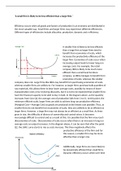‘A small firm is likely to be less efficient than a large firm.’
Efficiency occurs when all goods and factors of production in an economy are distributed in
the most valuable way. Small firms and larger firms may experience different efficiencies.
Different types of efficiencies include allocative, productive, dynamic and x efficiency.
A smaller firm is likely to be less efficient
than a large firm as larger firms tend to
benefit from economies of scale, which
increases the productivity efficiency of the
larger firm. Economies of scale occur when
increasing output leads to lower long-run
average costs. For example, the retail
company IKEA is likely to be much more
efficient than a small local furniture
company, as IKEA manages to benefit from
economies of scale, whereas the smaller
company does not. Large firms like IKEA may benefit from purchasing economies of scale,
whereas smaller firms are unlikey to. For instance, as larger firms purchase bulk quantites of
raw materials, this allows them to bear lower average costs, possibly by means of lower
transportation costs or by receiving discounts, but it is not to be expected that smaller firms
have the financial capacity to be able to buy in bulk. In the diagram above, as the quantity
increases from Q to Q2, the average cost of production falls from C to C1. At this point, the
minimum efficient scale, larger firms are able to achieve long run productive efficiency
(Marginal Cost = Average Cost) as goods are produced at the lowest cost possible. Thus, as
smaller firms do not benefit from economies of scale, they are unlikely to be as efficient as
larger firms. However, a large firm may not always be as efficient as a small firm. As firms
grow in size, the difficulty of divorce of ownership and control arises. It becomes
increasingly difficult to control and as a result of this, it is possible that the firm may reach
diseconomies of scale. Diseconomies of scale occurs when there is an increase in long run
average costs as output increases. In the diagram above, it can be seen that after the point
Q2, the LRAC curve starts to rise as costs increase. This then negatively affects the
productive efficiency of the firm and for
this reason, a smaller firm may be more
effective than a larger one.
Additionally, large firms are more likely to
be dynamically efficient than small firms.
Dynamic efficiency occurs when over time




